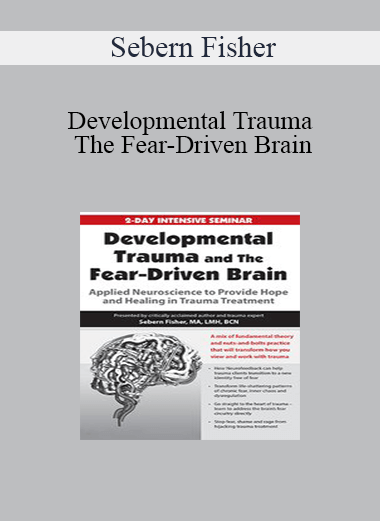- Faculty:
- Sebern Fisher
- Duration:
- 12 Hours 4 Minutes
- Format:
- Audio and Video
- Copyright:
- Sep 17, 2018
Description
Outline
Insecure Attachment and Developmental Trauma
- Neuronal patterns of PTSD
- The innate potential for relationship
- Unrepaired attachment disruption
- The inheritance of insecure attachment – the state of baseline survival fear
- Long-term consequences – void of self
The Fear-Driven Brain: Adverse Childhood Experiences and Trauma
- The traumatized brain
- The autonomic and central nervous systems
- The brainstem and hypothalamus
- The cerebellum, hemispheres and lobes of the brain
- Neurodevelopmental consequences
- Impaired brain development
- Impaired emotional regulation and impulse control
- Dysregulated stress response
- Alterations in physical growth
- Telomeres and cellular aging
- The firing and misfiring of neural networks
- Parasympathetic Nervous System shutdown and the vagal nerve
- Polyvagal Theory in trauma practice – Porges
- The role of glial cells
- Accessing brain plasticity
Arousal, Reactivity, and Affect Dysregulation in Trauma
- Overarousal and affect dysregulation
- Primary, sub-cortical and right hemisphere affects
- The inherent limits of talk therapy
- Chronic baseline fear and self-reflection
- The role of affect regulation in therapeutic effectiveness
Stop Letting Fear, Shame and Rage Hijack Trauma Treatment
- Shortcomings of medication
- The relationship between fear and shame
- Cognition in “survival mode”
- Manifestations of limbically driven emotions
- Neurofeedback and the pulses of fear, shame and rage
Fear as the Core of Transference: Handle Transference and Counter-Transference Issues
- Critical interpersonal dynamics – a partnership in affect regulation
- Impacts on the therapeutic bond
- Minimize intense transference
- Cultivate presence and attunement
- Neurofeedback and quieting the alarm of abandonment
Neurofeedback as Applied Neuroscience in Psychotherapy: Essentials and Assessment
- The risks of treatment
- Shift the burden of affect regulation from the therapist to the training
- A new experience of homeostasis
- Firing, frequencies, and arousal
- Strengthen circuits
- State dependence – fear states dysregulate
- States to traits
Quiet Fear with Neurofeedback: Integrate Neurofeedback into Trauma Treatment
- When to talk and when to train
- Clinical assessment for neurofeedback
- Attention, anxiety, depression, etc.
- Considerations regarding sexuality and medication
- Work with sensors, placements
- Identify maladaptive patterns of neuronal firing
- Using EEG – frequencies and amplitudes
- Adjust function – operant conditioning of brain waves
- Feedback – change the frequencies attributed to over-arousal
- Inhibit frequencies you want less of
- Reward frequencies you want more of
- Reward disconnected areas to connect or overly connected parts to disconnect
- When training plateaus – lack of progress is not resistance
- How do you know when training is over?
Who Will I Be When I’m Not Afraid: Working with the Fear-Bound Identity
- A trauma identity inextricably bound to fear
- The healing paradox
- Treatment challenges when fear begins to quiet
- Transition clients to an unfamiliar identity
- Integration of new state, new traits and new sense of self
Faculty
Sebern Fisher, MA, LMH, BCN Related seminars and products: 3
Sebern Fisher, MA, LMH, BCN is an internationally recognized expert on the use of neurofeedback in the treatment of developmental trauma and best-selling author of Neurofeedback in the Treatment of Developmental Trauma: Calming the Fear-Driven Brain. She has been working with traumatized people for over 35 years and has integrated Neurofeedback and psychotherapy in her treatment of developmental trauma in adults and adolescents for the past 20 years.
Prior to adopting Neurofeedback, Sebern was the clinical director of a residential treatment program for severely disturbed adolescents for 15 years. While there she introduced the understanding of the impact of attachment rupture and was the first to implement DBT in a residential setting.
Sebern consults and trains on the integration of Neurofeedback and therapy, nationally and internationally.
Speaker Disclosure:
Financial: Sebern Fisher is in private practice. She is an author for W.W. Norton and receives royalties. She receives a speaking fee from EEGer. Ms. Fisher receives a speaking honorarium from PESI, Inc.
Non-financial: Sebern Fisher has no relevant non-financial relationship to disclose.
Delivery Method
– After your purchase, you’ll see a View your orders link which goes to the Downloads page. Here, you can download all the files associated with your order.
– Downloads are available once your payment is confirmed, we’ll also send you a download notification email separate from any transaction notification emails you receive from https://coursesblock.com/
– Since it is a digital copy, our suggestion is to download and save it to your hard drive. In case the link is broken for any reason, please contact us and we will resend the new download link.
– If you cannot find the download link, please don’t worry about that. We will update and notify you as soon as possible at 8:00 AM – 8:00 PM (UTC 8).
Thank You For Shopping With Us!







